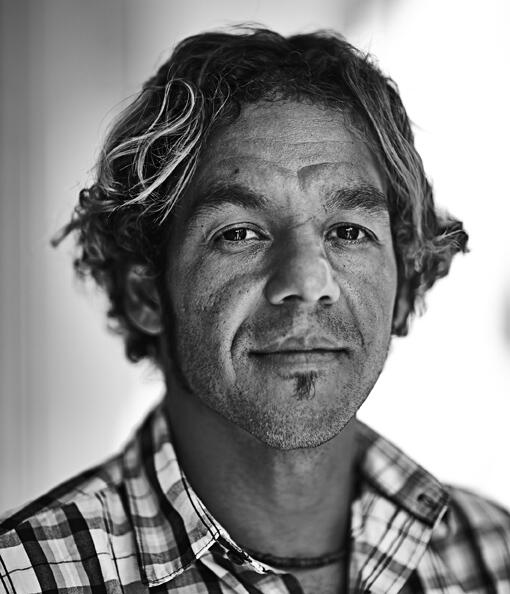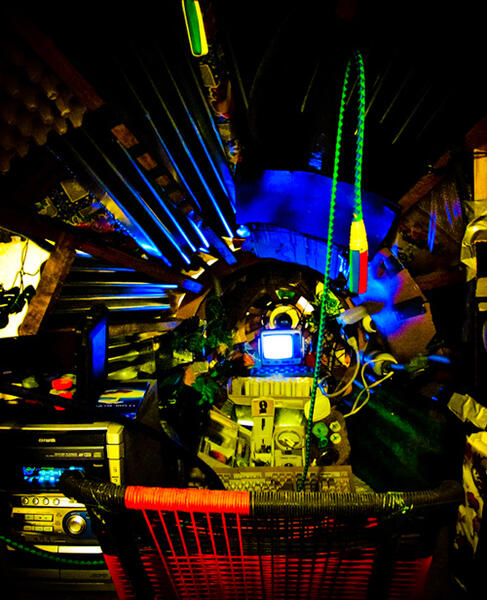Simón Vega: When Worlds Meet
What does it feel like to be a Salvadoran artist in the midst of an international career, with a creative practice that is entrenched in notions and experiences of home?

Simón Vega will tell you that dealing with this dichotomy in his artwork is not all in a day’s work. In fact for the past few years, Vega has been studying, travelling, collecting rubbish, building and discarding, only to do it all over again in new and often foreign locations—most recently creating his own version of a space satellite titled Third World Sputnik from found objects, at this year’s Venice Biennale. Such is the nature of creating ephemeral ‘self-made’ work. However, Vega will also likely tell you that it is this duality of living between experiences of ‘home’ and within the ‘first world’ contemporary art economy that provides him with thematic fuel to create works that simultaneously provoke questions about disparity in our world, and propose a space where duality can non-hierarchically co-exist.
Although Simón Vega’s sculptural installations are distinct, often recognizable as assemblages of found materials that almost always comprise a wooden or cardboard structure with meticulously added pieces of refuge that double as a pilot’s chair, a control panel, or a camera cable, his creative practice is born from an eclectic approach to media. Over the past decade, Vega’s work has comprised research projects, vinyl wall installations as well as site-specific installations of varying shapes and sizes, and more recently sculptural interventions and drawings. In 2002, Vega began a yearlong research project studying and photographing the decorations on urban buses in the cities of San Salvador and La Libertad. The project, “Transurbana 2002-2005” , resulted in photographs, drawings, paintings, luminous signs, bus seats and wall and window installations created in collaboration with the decal and furniture specialists who worked on the actual buses. Following this, Vega began Panopticams, a series of faux-surveillance cameras made of cardboard, bottles and wire. Initially installed as single cameras, Vega soon developed the series creating Panopticam chandelier- and tower installations that reference the design of the Panopticon—a jail designed by Jeremy Bentham in the 18th century that features an illusive center tower surrounded by a circle of exposed prison cells, giving the prisoners the impression of being under continued surveillance. Despite being entirely functionless, Vega’s Panopticam’s are imposters of surveillance that assume the authority of the watcher and thus make the faux-camera’s simultaneously farcical and deeply unnerving in their relentless gaze.
Vega melds typecasts of the developing world and its’ self-made architecture—shantytowns and prefabricated structures—with references of advanced technology and futuristic aspirations affiliated with the ‘developed’ world. It is this thematic of marrying two seemingly disparate worlds that is consistent throughout Simón Vega’s work. Third World Rover Explorers, 2010, a site-specific installation for the exhibition Coca-colonized at BrotKunsthalle in Vienna, combined the robotic designs of actual NASA Mars Rovers with that of the ad-hoc designs of vendor carts built to traverse the streets of El Salvador to sell wares. These seemingly disparate vehicles are essentially both explorers of their respective terrain. As such, Vega’s Third World Rover Explorers combine the design of practical navigation with that of space discovery to become its own unique machine.
The contrast between the designs required for space exploration and the ‘fundamental’ designs requirements for living could not be further apart, however in Simón Vega’s work they seem oddly at home with each other. Tropical Mercury, 2011 exhibited at MARTE Museum in San Salvador, is a to-scale recreation of the Project Mercury Ballistic capsule, the first United States space program capsule created to launch a human in orbit around Earth. Ironically, the Russian space program had the same aims, and launched Yuri Gargarin in to orbit a month before the US succeeded—rendering the Project Mercury Ballistic capsule obsolete. Parodying the absurdity of this ‘space race,’ Tropical Mercury is a static ‘third world’ interpretation of the Ballistic capsule that is instead made of wood, corrugated iron, discarded piping, bottles, a beach chair, a television, a Hi-Fi and other colorful detritus that assemble a plush trash interior. These materials commonly associated with construction, transform the capsule into an ad-hoc home that is no longer centered on orbiting Earth but simply living on it. Despite being a “Heath Robinson” contraption, it does suggest the nostalgic possibility that one-day it might fly, and that its function is as worthy as that of the Ballistic space capsule.
It can be argued that Simón Vega simply melds those focused on ‘progressive’ and capitalist-driven endeavors with those focused on subsistence, thus confronting the disparity between rich and poor, but this is too simplistic. Instead, Simón Vega has established an ‘aesthetic of fundamentalism’, that purposefully does not appear disenfranchised, but is infused with the power of surveillance and discovery affiliated with ‘first world’ endeavors. The result is artwork that traverses time zones, appears recognizable but is in fact removed from reality, and aims to break down the boundaries of what constitutes the ‘developing’ and the ‘developed’ world by suggesting a space for practical progress in a gesture of utopian solidarity. This is not to suggest that Vega is offering us an idealized middle ground or to dismiss the grave social and political critique within his work, but it does suggest that Vega is creating a space for living that, at the risk of sounding sentimental, may just be the best of both his worlds.
If this is true then Simón Vega crash-landed a space for himself in the Latin American Pavilion, ILLA, at this year’s 55th Venice biennale creating an installation Third World Sputnik, 2013. Third World Sputnik is a makeshift structure that recreates the Russian sputnik space satellite, Korabl-Sputnik 5, in shantytown architecture. Its rudimentary wooden shell contrasts the futuristic shimmer of its soda can surface creating tension. This tension could allude to El Salvador’s historically tenuous relationship with Russia. Many feel that El Salvador became a bargaining chip between Russia supporting the country’s guerillas during its civil war, and the USA who had invested support in the country’s military. It is apt then that Third World Sputnik has crash-landed leaving a trail of debris in its path. The Russian Korabl-Sputnik 5 was used as the last test flight before Yuri Gargarin’s first human flight, launching a mannequin and a dog in to space. Vega’s sputnik rendition emanates light and the sound of a marketplace suggesting the reality of everyday life is part of its travels. In this way, Third World Sputnik is at once a reference to cutting edge space technology and charmingly ineffectual, instead offering the suggestion of travelling from a market place in El Salvador to crash as an exotic locale on the floor of ILLA.
In one way, Simón Vega’s work is a reflection of the duality of what it means to be simultaneously a citizen of El Salvador and an artist of the international art world. More significantly, it is the creation of a third space—as a unique amalgamation of these two worlds infused with longstanding social and cultural ideologies as well as ideologies of hope and freedom offered by the ambitions of space travel—that he is asking us to reassemble and renegotiate in to a more thoughtful, practical and live-able solution.
Biography
Simón Vega was born in San Salvador, El Salvador in 1972. His childhood and teenage years were spent in tandem with El Salvador’s thirteen-year-long civil war, which ended in 1992. In 1994, Vega moved to Mexico to study at the University of Veracruz, graduating with a degree in Fine Arts. He then received a scholarship from the Spanish Agency for International Cooperation for Development (AECID) to study at the Complutense University in Madrid, where he graduated with a Master´s degree in Contemporary Arts in 2006. Whilst studying, Vega exhibited his work in Spain, Portugal and the USA, and participated in the 2006 Havana Biennial in Cuba. After graduating, Vega returned to El Salvador, exhibiting his work locally, and expanding his reach throughout Latin America, Europe and the United States. Vega’s work was featured at Zona Maco in Mexico City in 2007, at the Bronx River Art Center in New York in 2009, Hilger BROTKunsthalle in Vienna in 2011, El Museo del Barrio’s Biennale in New York in 2012, and most recently at the 2013 55th Venice Biennale. Simón Vega currently lives and works in La Libertad, El Salvador.






